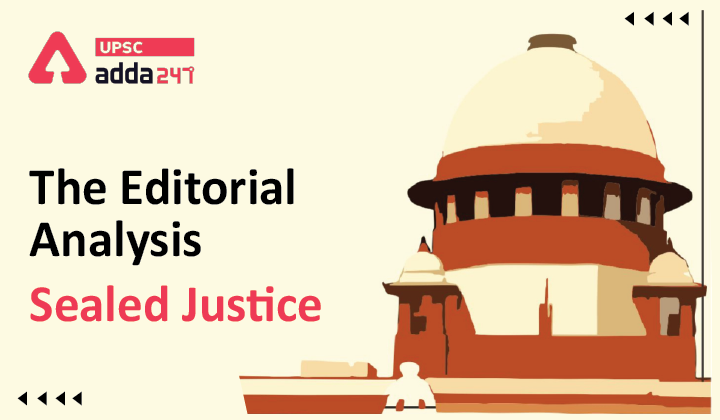Table of Contents
Sealed Justice- Relevance for UPSC Exam
- GS Paper 2: Indian Constitution- Structure, organization and functioning of the Executive and the Judiciary Ministries and Departments of the Government.
Sealed Justice in news
- In refusing to entertain ‘sealed covers’ submitted by the government or its agencies, the Supreme Court has made a noteworthy and welcome shift away from this unedifying practice.
- Recently, in the Muzaffarpur shelter home sexual abuse case, Chief Justice N.V. Ramana wondered why even an ‘action taken’ report should be in a sealed envelope.
Supreme Court’s Observation
- In the news channel Media One case, the Supreme Court has decided that it will examine the issue of ‘sealed cover jurisprudence’ while hearing the channel’s appeal.
- For now, the apex court has stayed the revocation order and allowed the channel to resume broadcasting.
Supreme Court Allows Legal Sand Mining in Rajasthan
Issues with the Practice of Sealed Covers
- Expands the Discretion of Judges: Courts have often justified entertaining material not disclosed to the parties by underscoring that it is to satisfy their conscience.
- In some cases, courts have allowed such secret material to determine the outcome. For example-
- Kerala High Court perused confidential intelligence inputs produced in a sealed envelope by the Union government to uphold the validity of orders revoking the broadcasting permission given to Malayalam news channel Media One.
- This was done on the ground of national security.
- Snatches Right to Know of Opposition: In recent years, often the contents of the sealed cover were withheld from lawyers appearing against the government but being seen by the judges alone.
- It means courts can rule in favour of the government without providing an opportunity to the affected parties to know what is being held against them.
- Misuse of Broad and Vague provisions of Law: The government usually justifies the submission of secret material directly to the court, citing national security or the purity of an ongoing investigation.
Undesirable Consequences of the Practice of Sealed Covers
- It compromises the defence of those accused of some crimes, especially those involving an alleged threat to national security, or money laundering and corruption.
- Undisclosed material is often used to deny bail, something the apex court criticised the Delhi High Court for doing in a case against former Union Minister P. Chidambaram.
- It observed that recording a finding based on material kept in a sealed cover was not justified.
- The main mischief of the ‘sealed cover’ practice lies in the scope it gives the state to avoid deep scrutiny of the need and proportionality of its restrictions on freedom.
Conclusion:
- The use of material produced in a ‘sealed cover’ as an aid to adjudication is something to be strongly discouraged and deprecated.
- The Supreme Court must determine and circumscribe the circumstances in which confidential government reports, especially those withheld from the other side, can be used by courts in adjudication.
The Editorial Analysis- Needed, an Indian Legislative Service
The Editorial Analysis- Needed, an Indian Legislative Service





 TSPSC Group 1 Question Paper 2024, Downl...
TSPSC Group 1 Question Paper 2024, Downl...
 TSPSC Group 1 Answer key 2024 Out, Downl...
TSPSC Group 1 Answer key 2024 Out, Downl...
 UPSC Prelims 2024 Question Paper, Downlo...
UPSC Prelims 2024 Question Paper, Downlo...





